|
Report from
Europe
Rebound in UK imports of tropical wood and wooden
furniture
The UK imported tropical wood and wooden furniture
products with a total value of USD1.1 billion in the first
ten months of 2021, a 38% increase compared to the same
period in 2021. Import value to end October this year was
also 4% more than the same period in 2019 before onset of
the COVID pandemic.
Following the sharp increase in April this year, when
import value was at the highest monthly level since before
the financial crises of 2008-2009, imports declined only
slightly from this peak between May and October (Chart
1).

This year the UK has experienced a very robust rise in
construction sector activity and in timber trade and
consumption.
There has been a welcome rebound from the lows of last
year in the value of wood product imports from tropical
countries into the UK, and importers are benefiting from
strong sales, high prices and larger margins. The main
constraints to increased imports this year have been on the
supply side.
The latest UK Construction Products Association (CPA)
Trade Survey shows construction continued to expand
during the third quarter of this year, with private housing
and repairs, maintenance and improvement leading the
industry. Much of the activity in these sectors has been
sustained by government housing policies, an increase in
the disposable income across households in the UK, and a
homeworking trend that has been driving demand for
greater or improved outdoor and office space.
According to the Building Merchants Building Index
(BMBI), UK sales of timber were at their highest ever
level and performing better than all other building material
categories in the third quarter of 2021. Sales were 5%
higher than the previous quarter, 44% up on the same
quarter the previous year and 49% higher than the same
quarter in 2019. According to the UK Timber Trade
Federation, longer term prospects for timber demand in the
UK are good, but short term logistical issues are putting
severe strain on supply.
While UK construction activity remained robust in the
third quarter, the latest UK Office of National Statistics
data indicates that activity declined by 1.8% in October
compared to September, the sharpest fall since the initial
COVID lockdown in March 2020.
The main reason for the downturn was shortages in the
supply and sharp increases in prices of key construction
materials, including timber, due to a combination of
ongoing COVID restrictions, Brexit delays and shipping
hold-ups. The volatile price and supply environment was
hindering new business as construction companies revised
cost projections and some clients delayed decisions on
contract awards.
However, the latest IHS Markit/CIPS UK Construction
Purchase Managers Index (PMI) for November suggests
that the downturn in October was short-lived. At 55.5 in
November, up from 54.6 in October, the PMI signalled a
robust and accelerated expansion of overall construction
activity in the UK during the month (any number over 50
indicates growth).
According to Tim Moore, director at IHS Markit,
"November data highlighted a welcome combination of
faster output growth and softer price inflation across the
UK construction sector. Commercial building led the way
as recovering economic conditions ushered in new
projects, which helped compensate for the recent
slowdown in house building". Tim Moore also noted that
"input price inflation remains extremely strong by any
measure, but it has started to trend downwards after hitting
multi-decade peaks this summer.
The latest rise in purchasing costs was the slowest since
April, helped by a gradual turnaround in supply chain
disruption and a slight slowdown in input buying. Port
congestion and severe shortages of haulage capacity were
again the most commonly cited reasons for longer lead
times for construction products and materials."
Recovery in UK furniture imports from tropical
countries
The UK imported USD630 million of tropical wooden
furniture in the first ten months of this year, 40% more
than the same period in 2020, but just 4% more than the
same period in 2019. After a slow first quarter this year,
when lockdowns once again disrupted trade, imports
strengthened considerably in the second quarter to reach
monthly highs not seen for over a decade. The pace of
imports slowed only a little in the third quarter.
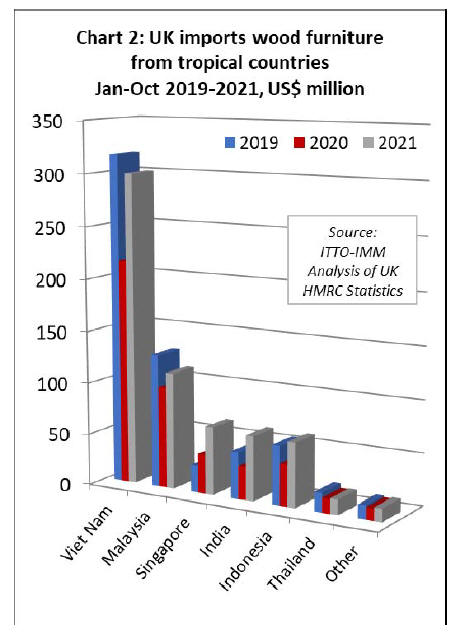
Overall during the first ten months of 2021 compared to
the same period last year, UK wooden furniture imports
were up from all the leading tropical supply countries to
this market; Vietnam (+39% to USD300 million),
Malaysia (+15% to USD112 million), Singapore (+75% to
USD65 million), India (+94% to USD62 million),
Indonesia (+53% to USD62 million) and Thailand (+4% to
USD15 million).
While gains were made across the board when compared
to the depressed levels of 2020, wooden furniture import
value in the first ten months of 2021 was still trailing the
pre-pandemic 2019 level from Vietnam (-5%), Malaysia (-
12%), and Thailand (-20%).
In contrast, imports were significantly higher than in 2019
from India (+40%), Indonesia (+9%), and Singapore
(+148%).
Singapore has become more important as a supply hub due
to logistical problems elsewhere during the pandemic
(Chart 2 above).
UK tropical joinery imports exceed pre-pandemic level
UK import value of all tropical wood products in Chapter
44 of the Harmonised System (HS) of product codes was
USD469 million in the first ten months of 2021, 35% more
than the same period last year and 3% up on the same
period in 2019.
Comparing UK import value in the first ten months of
2021 with the same period in 2020, tropical joinery was up
46% at USD186 million, tropical plywood was up 38% at
USD147 million, tropical sawnwood was up 10% at
USD70 million, and tropical mouldings/decking was up
47% at USD21 million.
While import value of tropical joinery in the first ten
months of this year was also up 29% on the pre-pandemic
level in 2019, UK import value of all other HS 44 tropical
wood products was significantly behind the 2019 level,
including plywood (-9%), sawnwood (-15%), and
mouldings/decking (-9%) (Chart 3).

After the sharp dip in UK imports of tropical joinery
products during the first lockdown period in Q2 2020,
imports gradually built momentum until March this year
and then surged in the second quarter.
Imports from Indonesia (mainly wooden doors) continued
to rise in the third quarter but imports from Malaysia and
Vietnam (mainly laminated products for kitchen and
window applications) slowed during this period.
Joinery product imports from Indonesia were USD118
million in the first ten months of 2021, 64% more than the
same period last year and 37% up on the same period in
2019. Imports from Malaysia were USD35 million
between January and October this year, 3% more than the
same period in 2020 and 2% up on the same period in
2019.
Joinery product imports of USD13 million from Vietnam
were 62% more than in the same period in 2020 and 60%
more than the same period in 2019 (Chart 4).
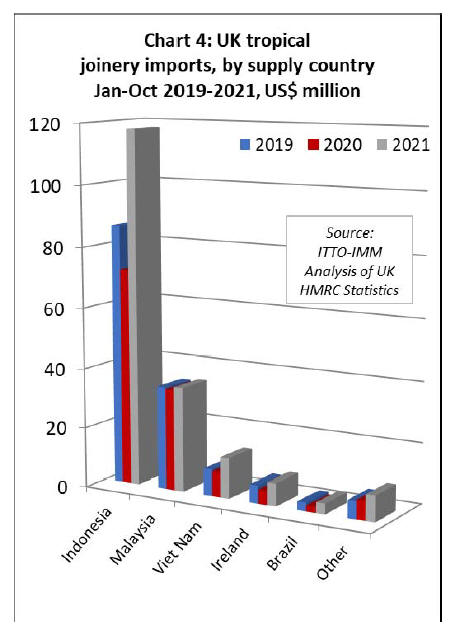
UK tropical plywood imports still at low levels
In contrast to joinery products, UK imports of tropical
hardwood plywood have remained at relatively low levels
this year. In the first ten months of 2021, the UK imported
250,900 cu.m of tropical hardwood plywood, which is
16% more than the same period in 2020 but still down
18% compared to the same period in 2019.
Imports from the UK¡¯s three largest suppliers of tropical
hardwood plywood ¨C China, Indonesia and Malaysia ¨C
have followed very different trajectories this year (Chart
5). The UK imported 85,800 cu.m of tropical hardwood
faced plywood from China in the first ten months of this
year, down 9% compared to the same period in 2020 and
48% less than the same period in 2019.
In contrast, Malaysian plywood has made gains in the UK
market this year, imports of 58,000 cu.m in the first ten
months being 7% more than the same period in 2020 and
31% up on the same period in 2020. But these gains are
being made against historically very low levels after a long
period of decline in UK imports of Malaysia plywood in
the years before 2019.
This year, UK imports of plywood from Indonesia have
also rebounded from the lows of 2020 this year, a trend
which gained momentum in the third quarter. Plywood
imports of 61,300 cu.m from Indonesia in the first ten
months of this year are 106% more than the same period in
2020 and 24% more than the same period in 2019.
As for other hardwood product groups, UK demand for
tropical hardwood plywood has been strong this year,
driven by high levels of construction activity and
shortages of competing materials. The main market
challenges have been on the supply side, notably the
considerable escalation in freight rates on Asian routes to
the UK.
A 40ft container from Malaysia or Indonesia as late as last
autumn cost US$1500-2000. By Q2 2021 UK importers
were being quoted over US$15,000 and rates have
remained at these record high levels in the second half of
the year.
This has encouraged a partial switch to breakbulk
shipments out of Southeast Asia into the UK, although this
has proved a challenging option. When the breakbulk
vessel Konya arrived into the port of London from
Malaysia in summer this year, the first such arrival for 30
years, it took weeks to discharge the cargo, partly as the
port was so busy and partly because personnel weren¡¯t
used to the work.
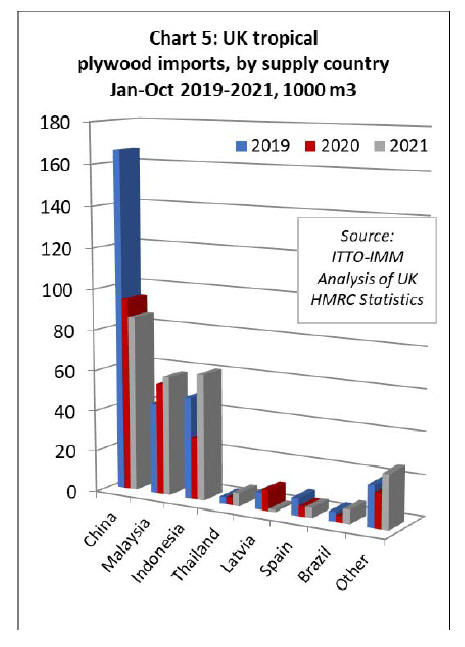
Supply issues constrain UK imports of tropical
sawnwood
After falling sharply in May and June last year, UK
imports of tropical sawnwood slowly increased during the
course of the next 12 months, but the pace of increase
began to slow again in the third quarter of 2021.
Throughout this period, the rebound in UK tropical
sawnwood imports has been impaired by significant
logistical problems on the supply side.
UK imports were 70,100 cu.m in the first ten months of
2021, just 1% more than the same period in 2020 and 18%
less than the same period in 2019. Although imports from
Cameroon, now by far the leading supplier of tropical
sawnwood to the UK, were up 44% on 2021 and up 60%
on 2019 during the ten month period, imports from nearly
all other leading tropical sawnwood supply countries have
remained weak this year (Chart 6).
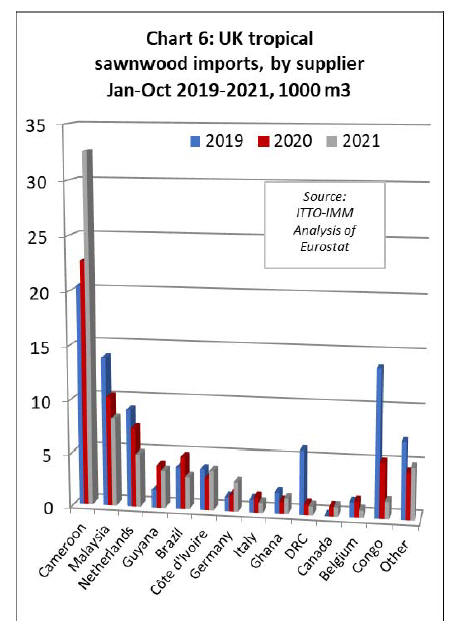
The large increase in imports of sawnwood from
Cameroon this year reflects the long lead time in shipment
of contracts placed back in 2020. UK importers report that
securing supplies for hardwoods from Cameroon and other
African supply countries has continued to be very
challenging.
While iroko is currently reported by UK importers to be
more readily available, utile is described as ¡®very scarce¡¯.
There are differing views on sapele supply, with some
importers reporting they have secured sufficient volume
while others have been unable to do so.
UK imports of tropical sawnwood from Côte d'Ivoire were
3,700 cu.m in the first ten months of this year, 22% more
than the same period in 2020 but still down 4% on the
same period in 2019. The UK was previously a significant
buyer of framire from Côte d'Ivoire but UK importers
report that this species is proving increasingly difficult to
source, both due to a lack of raw material in the forest and
the challenges of obtaining assurances of legality that
satisfy UK Timber Regulation requirements.
Meanwhile, UK imports of tropical sawnwood from both
the Republic of Congo and DRC have fallen to a trickle
since the start of the pandemic. Imports from the Republic
of Congo were just 1,614 cu.m in the first ten months of
the year, down 69% and 88% compared to the same period
in 2020 and 2019 respectively. Imports from DRC were
836 cu.m during the 10 month period, which is 17% less
than in 2020 and 86% down compared to 2019.
After an extremely slow start to the year brought on by
pandemic induced production problems and extreme
shortages of containers, UK imports of tropical sawnwood
from Malaysia picked up a little during the summer with
the arrival of breakbulk shipments of Asian meranti and
keruing lumber into the UK. UK imports of Malaysian
sawnwood were 8,235 cu.m in the first ten months of
2021. That is still 19% less than the same period last year
and 41% down on the same period in 2019.
With shortages in supply from other sources, UK
importers were turning more to South America in the
opening months of this year. Imports from Brazil were
quite good in the first quarter but ground to a halt in the
second and third quarters.
By the end of the first ten months, total UK imports of
tropical sawnwood from Brazil were just 3,000 cu.m, 38%
less than the same period last year and 22% down
compared to 2020. Imports from Guyana have been
slightly more robust, at 3,500 cu.m in the first ten months
this year, 12% less than the same period in 2020 but
double the volume imported in the same period in 2019.
Indirect UK imports of tropical sawnwood from other EU
countries have fallen dramatically this year. Total UK
imports from EU countries were 11,400 cu.m in the first
ten months of 2021, 16% less than the same period last
year and 35% down on the same period in 2019.
The UK imported 7,700 tonnes of tropical hardwood
mouldings/decking in the first ten months of 2021, 28%
more than the same period in 2020 but still 26% less than
the same period in 2019. The arrival of the first breakbulk
shipments into the UK this year boosted imports a little
from Indonesia, which at 2,800 tonnes in the first ten
months were 3% more than the same period in 2020, but
still down 52% compared to 2019.
Similarly, imports from Malaysia, at 1,900 tonnes, were
7% more than the same period in 2020 but 33% less than
in 2019. Imports of decking products from Brazil have
also picked up a little, at 1,800 tonnes in the first ten
months, around twice the quantity imported during the
same period last year and 11% more than in 2019 (Chart
7).
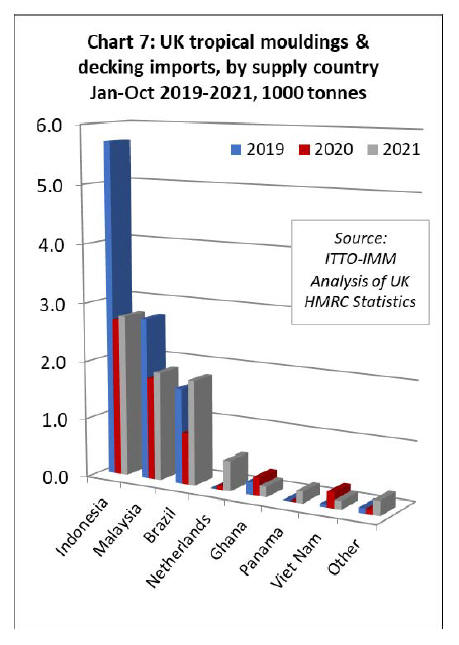
The UK market is currently suffering from severe lack of
availability of tropical hardwood decking, due both to the
freight hikes and also to suppliers preferring to sell the
limited stocks they have available to other markets. This
has encouraged some UK importers to purchase more
tropical decking from importers in the Netherlands. The
UK imported 520 tonnes of tropical hardwood decking
from the Netherlands in the first ten months of this year
when previously very little was sourced from there.
|